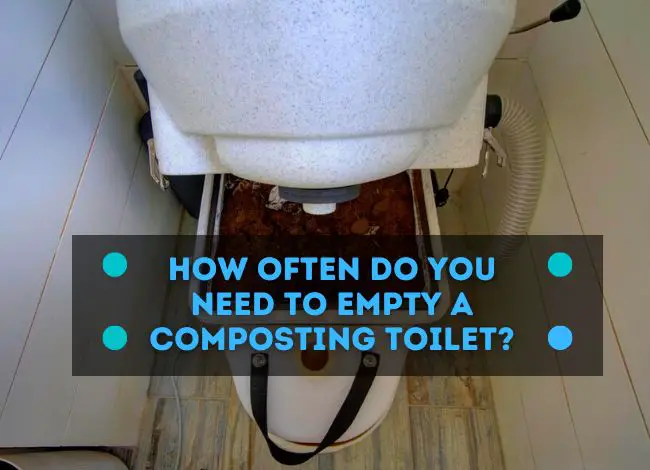
Emptying a composting toilet isn’t as difficult as it may seem, but it does require careful attention to the system’s mechanism. Once the waste container is full, you must cautiously remove the seat panel to access the contents. The disposal process follows a hygienic and eco-friendly system designed to manage waste efficiently. Commercial composting toilets are typically emptied every 2 to 3 months, depending on usage. The unit separates solid and liquid waste and gradually transforms it into nutrient-rich fertilizer.
Let’s explore how often you need to empty your composting toilet and what factors influence the process.
What to Consider When Emptying a Composting Toilet
Several important factors determine how frequently a composting toilet needs to be emptied:
- Size of the composting chamber
- Number of users in the household
- Type and consistency of waste (solid or liquid)
- Type of composting toilet (self-contained or split system)
- Flow and processing capacity of black water
- Usage pattern (full-time or occasional)
How Often Should You Empty a Composting Toilet?
The frequency of emptying a composting toilet depends on several usage-related factors. In general:
- For regular household use, the solid waste container may need to be emptied every 1 to 2 months.
- For commercial or high-traffic toilets, emptying is recommended every 2 to 3 months.
The composting process relies heavily on proper ventilation and moisture control. Most toilets feature a vent hose system to eliminate unpleasant odors and reduce the risk of gas build-up. Additionally, heating elements in advanced units help accelerate composting by evaporating excess moisture and maintaining an ideal decomposition environment.
Composting Toilet Types
- Split/Continuous/Central System Composting Toilets:
These composting toilets consist of two main parts: a pedestal seat and a separate composting tank located below the floor. They require underfloor access, making them suitable for homes, parks, and commercial facilities. Typically, these systems need to be emptied every 3 months. However, in high-traffic areas, they may need to be emptied every 2 to 3 weeks.
- Self-Contained/Batch System Composting Toilets:
Self-contained composting toilets are ideal for compact spaces like RVs, boats, tiny homes, or basements. They don’t require electricity or underfloor installation. These toilets usually include 2–3 removable bins for waste collection, with each bin taking around 3 to 5 weeks to fill depending on usage.
How to Empty a Composting Toilet: A Step-by-Step Guide
Emptying a composting toilet can sometimes be an odor-prone task if not done properly. Here’s a practical and hygienic guide on how to empty any type of composting toilet safely and efficiently.
1. Prioritize Safety and Sanitation
Start by wearing protective rubber gloves, a mask, and if possible, safety glasses. The compost may contain bacteria essential for the decomposition process, so personal protection is key.
2. Remove the Compost
Use a small shovel or spade to carefully scoop the composted material from the waste bin. Place the contents into a designated compost bag or composting pile in your garden (if allowed).
3. Clean Up
After emptying the compost, thoroughly wash your hands with soap and water, and apply hand sanitizer for added safety.
4. Dispose with Care
If you’re burying the compost, ensure the hole is at least 10 cm deep to avoid environmental contamination. Be cautious when handling large volumes, especially when digging or moving compost to a trench or disposal site.
Here’s the improved, grammatically correct, user-friendly, and keyword-optimized version of your paragraph:
How to Empty a Split Technology Composting Toilet?
Emptying a split technology composting toilet depends heavily on the design and size of the unit. The composting chamber holds the decomposed waste, and to remove it, you typically need a shovel and a wheelbarrow. Systems like the Sun-Mar Centrex series separate the key components for easier handling. Most of the compost collects at the bottom of the chamber, and it’s often transferred into a tray that can be emptied into a wheelbarrow. Overfilling this tray can affect the quality of the resulting fertilizer.
Final Thoughts
Composting toilets are especially popular in off-grid or water-scarce areas. Using a compostable bag and following a proper emptying routine can make maintenance much easier.
To keep your composting toilet odor-free, clean it regularly with natural or eco-friendly cleaners. Avoid harsh chemicals, as they can disrupt the composting process and lead to foul odors.
When disposing of urine in remote areas, take extra care to follow local guidelines. To reduce unpleasant smells, never empty composting waste near water bodies. Always use a compostable bag when removing and disposing of waste to maintain hygiene and sustainability.
This article outlines the essential steps and best practices for emptying a composting toilet. We’d love to hear your feedback—let us know how this guide helped you!
We are really lucky to have a hard-working, multi-skilled plumber on our team. Collin D. Gallegos, a professional plumber who has worked with us since 2012, is an expert in vent, septic, and drainage systems. He is a Certified Master Plumber and has worked on various commercial plumbing projects. He usually helps our readers resolve plumbing and pipe-related issues with a proper DIY troubleshooting and repair guide.